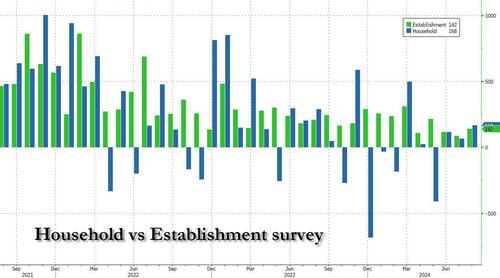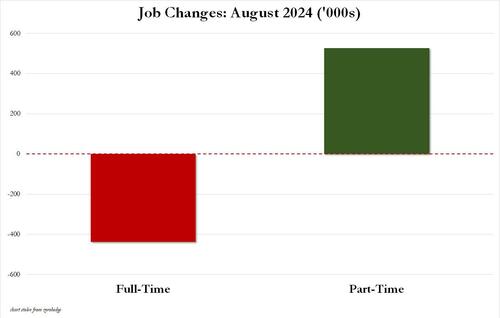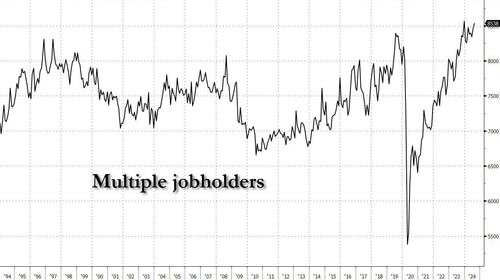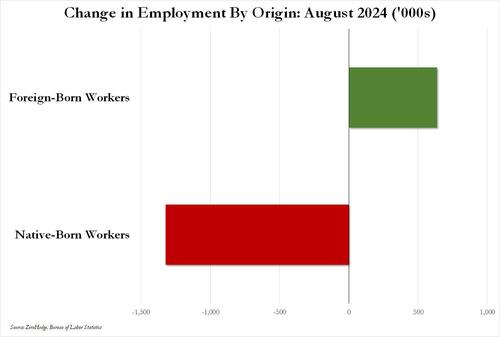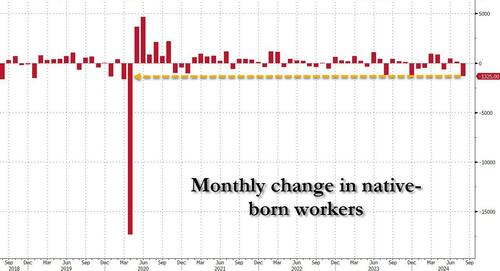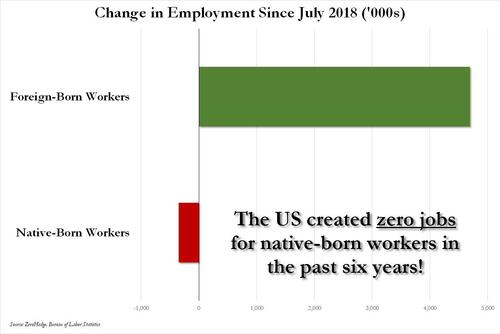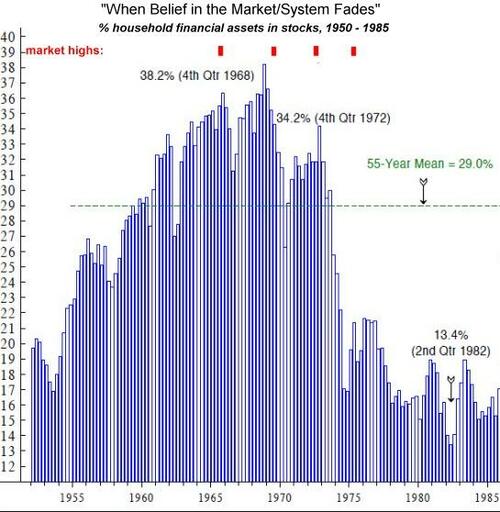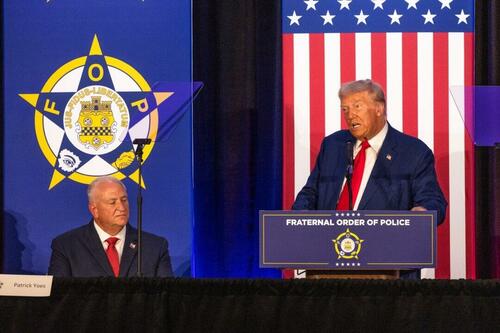Great Replacement Job Shock: 1.3 Million Native-Born Americans Just Lost Their Jobs, Replaced By 635,000 Immigrants
At the start of the year, many months after we first pointed out that the biggest untold story of the US labor market was the “great replacement” of native born workers with foreign-born workers (most of whom we subsequently learned were illegal aliens), we asked how is it, that the ongoing replacement (because that’s what it is) of US workers is “not the biggest political talking point right now” considering that “since October 2019, native-born US workers have lost 1.4 million jobs; over the same period foreign-born workers have gained 3 million jobs”
How is this not the biggest political talking point right now: since October 2019, native-born US workers have lost 1.4 million jobs; over the same period foreign-born workers have gained 3 million jobs. pic.twitter.com/Z5HVWmQ24C
— zerohedge (@zerohedge) January 15, 2024
Nine months later, we are delighted to see that our relentless efforts to bring attention to this critical topic finally worked, and the continued replacement of native-born workers with immigrants and illegal aliens was finally the biggest political and media talking point, as demonstrated by such articles as “How Immigration Remade the U.S. Labor Force“ by the WSJ and “Without Immigrants, US Working-Age Population Would Shrink“ from Bloomberg, both of which are an extension of the latest and greatest narrative, first spawned by Fed chair Powell, and then picked up by Goldman, which came down to the following: you can have (record) illegal immigration, or you can have even more (breakneck) inflation. So don’t be angry, and just accept the roving gangs of Venezuelan murderers in your neighborhood, if you know what’s good for you and if you want to keep prices low (the same prices which are only high because the government decided to inject $20 trillion in fiscal stimmies in the past 4 years).
There it is: You can have illegal immigration or you can have even more inflation https://t.co/4npStzH8ft pic.twitter.com/xYofvgPjXV
— zerohedge (@zerohedge) May 5, 2024
Which brings us to today’s jobs report… where the native vs foreign-born debate just exploded!
As we discussed earlier, superficially the August payrolls report was a mixed bag. On one hand, it was disappointing in that the payrolls print came in softer than expected, but was a big bounce from sharply downward revised June and July prints. On the other hand, the unemployment rate did drop from the Sahm Rule’s recession trigger level of 4.3% to 4.2%, and effectively eliminated the clear cut case for a 50bps rate cut, especially since the Household survey was not only far stronger than the Establishment survey, but indicated the biggest increase in employment since March.
That, at least, was the quantitative view. And while that was mixed, there was no confusion in the picture painted by the qualtitative aspect of the jobs report. Here, everything was a disaster.
Starting at the top, while the number of employed workers did rise by 168K, looking closer at the composition of this increase is disastrous: that’s because it consisted of an increase of 527K part-time jobs, offset by a 438K plunge in full-time jobs.
This means that since last June, the US has added just over 2 million part-time jobs, and lost over 1.5 million full-time jobs.
Needless to say, part-time jobs pay far less, don’t offer benefits, and generally lead to a suboptimal outcomes for the labor market, one of which is the need to get more than one job, and sure enough, the number of multiple jobholders – or people who for whatever reason have more than one job – jumped above 8.5 million, back to all time highs.
And while the quality of job gains in the past year has clearly been catastrophic – a necessary condition to give the impression that headline, or quantiative, job growth was strong – there was a very clear reason for that, and it goes back to what we have been pounding the table on in the past: the reason is the continued replacement of native-born workers with immigrants (some legal but mostly illegal). And as the following chart shows, it is anything but a theory: it is cold hard fact.
Presenting exhibit A: the number of native-born vs foreign-born workers in August.
In an absolute shocker of a data point, in the past month, the US added 635K foreign-born workers, while losing 1.325 million native-born workers. This was tied for the biggest one-month drop in native-born workers since the covid crash!
But it’s not just the past month, or two, or three… As regular readers know, the reason why suddenly we are bombarded with media pitches for why illegal immigrants are actually great for you, is that the US has not created a single job for native-born workers since July 2018! And in that interval, it has created 4.7 million jobs for immigrants, both legal and illegal.
Finally for those wondering when the Great Job Replacement Fact (again, not theory) kicked in, the following chart showing the historical divergence between native and non-native born workers will make it clear: the gap first emerged at the start of the Biden administration and has exploded to a record size today!
Finally, for those who would push back that these are mostly legal immigrants, here is what Standard Chartered strategist Steven Englander wrote at the start of June to refute that claims and prove that most of these immigrant workers are virtually all illegal: echoing what we have said for the past two years, Englander wrote that immigration, particularly illegal immigration, “is a political flashpoint that has also become an important factor in assessing economic performance. Detailed data from US Customs and Border Protection (CBP) and US Citizenship and Immigration Services (USCIS) suggest that half of non-farm payroll (NFP) growth to date for FY24 (started 1 October 2023) has been from undocumented immigrants who have received an Employment Authorization Document (EAD)” (he defines undocumented immigrants as those who entered the US through non-traditional immigration pathways, such as asylum seekers, parolees, and refugees, i.e. illegals).
“The ability to track EAD issuance to undocumented workers is an advantage in estimating how much they have contributed to employment growth. NFP counts workers with an EAD just like any other. Using that data, it is easy to estimate that undocumented workers have added 109k jobs per month to NFP out of the average 231k increase so far in FY24.”
Which is a big problem because as the BLS now admitted with its downward payrolls revision two weeks ago, the monthly increase in jobs in the past years was not 230K as it had indicated previously, but rather 150K when one removes the 818K jobs that were never there in the past year to begin with.
So if the true pace of job creation in the past year was 150K, and another 109K jobs per month are illegal aliens, that leaves just about 40K jobs for everyone else, i.e., law abiding Americans.
It also means that, great worker replacement scandal aside, the labor market in the US has – for the past year – been an absolute catastrophe and harbinger of economic disaster.
Tyler Durden
Sat, 09/07/2024 – 16:11
via ZeroHedge News https://ift.tt/clS8vaV Tyler Durden
